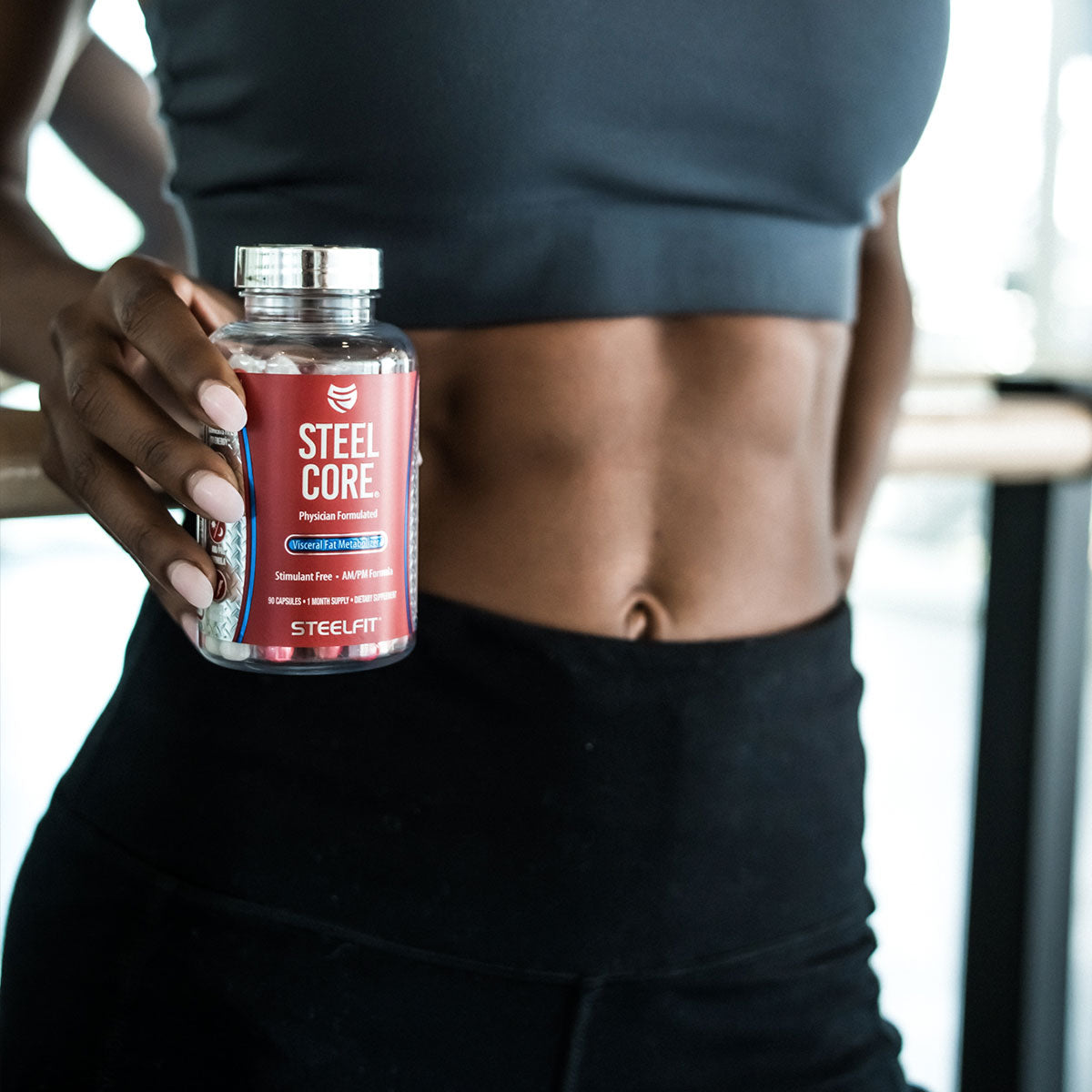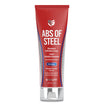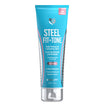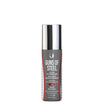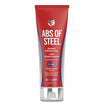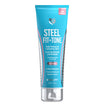If you want to know the facts about sodium and whether or not you need to watch your salt intake, then you want to read this article.
Sodium is one of the most ubiquitous minerals in existence. It's naturally occurring in many foods and forms the basis of the flavor-enhancing trifecta (fat, sugar, and salt) used to make processed foods hyper-palatable.
The mighty mineral plays a vital role in regulating the fluid balance in our bodies balance, and it’s even important for optimal muscle, nerve, and cognitive function. <1,2>
Much like eggs, coffee, and carbohydrates, sodium (and by proxy salt) has gotten a bad rap in the media and certain portions of the medical community.
Today, we set the record straight about sodium and salt intake as we delve headfirst into the facts about sodium and its effects on your health.
Let’s start by briefly discussing the difference between sodium and salt.
Sodium vs. Salt
While the terms sodium and salt are often used interchangeably, the two are exactly the same thing. Sodium can be a component of salt, but not all salts contain sodium.
You see, from a chemistry point of view, sodium is a metallic ion as well as an essential mineral.
Salt is any chemical compound formed from the reaction of an acid with a base. Essentially, a salt is a combination of two minerals held together by an ionic bond. In the case of table salt, sodium serves as the “metal” while chloride serves as the base.
Table salt is composed of 40% sodium and 60% chloride by weight. <3>
The Role of Sodium in the Body
As mentioned above, sodium is an essential mineral, meaning we cannot live without it. That being said, dietary sodium deficiencies are pretty rare sodium, even when individuals follow very low-sodium diets. <1,4>
The majority of the body's sodium can be found in the blood and extracellular fluid (the fluid that surrounds your cells). Besides its role in maintaining fluid balance, sodium also helps your nerves, brain, and muscles function correctly.
The kidneys are responsible for modulating the body’s sodium levels and regulates these levels by controlling how much is excreted through the urine. It’s also worth noting that you can lose sodium through sweating.
The reason that sodium has become such a polarizing mineral in recent years is that several studies have found an association between high sodium intake and hypertension as well as cardiovascular disease (CVD). <5>
Additional studies have found a like between hypertension and CVD and impaired cognitive function. <6,7>
However, the link between high sodium intake and impaired cognitive function may not be all that firm as some other research has found that too low of sodium intake can impair cognitive function. <2>
This begets the question...
How Much Sodium Should You Have Per Day?
According to the 2015-2020 Dietary Guidelines for Americans, Americans are advised to consume less than 2,300 milligrams (mg) of sodium per day as part of a healthy eating pattern. <8>
The Institute of Medicine (IOM) has also set an upper limit (UL) for daily sodium intake at 2300 mg/d. FYI, the “upper limit” is the highest amount an individual can consume where there is little to no risk of adverse health effects. <1>
This limit was established based on evidence from various studies that found an association between sodium intakes above 2,300 mg per day and increased blood pressure and heart disease risk.
However, these guidelines have been heavily debated in recent years, as some research indicates that consuming less than 2,500mg of sodium daily is associated with higher blood pressure. <9>
More specifically, researchers analyzed over 2,600 men and women over 16 years to track the long-term effects of salt consumption on systolic (SBP) and diastolic blood pressures (DBP).
Researchers observed after 16 years of follow-up that individuals with the lowest blood pressure levels had higher intakes of sodium and potassium while those with the highest blood pressure readings had lower intakes of both sodium and potassium. <9>
Researchers concluded the paper by stating that:
“We saw no evidence that a diet lower in sodium had any long-term beneficial effects on blood pressure. Our findings add to growing evidence that current recommendations for sodium intake may be misguided.”
What’s more, research from 2018 that followed 94,000 people from various parts of the world for an average of eight years and only found evidence of an associated risk of cardiovascular disease and strokes when the average intake is exceeded FIVE grams of sodium a day! <12>
Now, it should be mentioned that not all individuals respond similarly to sodium. For instance, individuals with high blood pressure, diabetes, and/or chronic kidney disease tend to be more sensitive to the hypertensive effects of sodium. <10>
Can You Eat Too Little Sodium?
According to the American Heart Association (AHA), the minimum physiological requirement for sodium is ~500 mg a day. This is the amount contained in roughly one-quarter teaspoon of table salt. <11>
Other estimates suggest the body only needs around 180 mg of sodium per day to function correctly.
As we mentioned at the outset, sodium is an essential mineral for the body, which means that it is possible to eat too little of it.
And, when you do drop below the minimum threshold of sodium needed by the body, you can develop a condition called hyponatremia, which occurs when sodium concentrations in the body become too diluted. This causes the cells to swell up with water, leading to a slew of complications, including headache, fatigue, reduced cognitive function, decreased physical performance, and nausea. If hyponatremia progresses to a severe state, it may even be life-threatening.
Individuals at risk for hyponatremia are older adults with impaired kidney function as well as individuals who take medication that affects sodium levels (e.g., diuretics).
Athletes who drink excessive amounts of water but fail to replace electrolytes lost through sweating are also at risk. <13> FYI, this is why virtually all sports drinks or intra-workout supplements contain added electrolytes.
Consuming too little sodium is hardly a concern for the average person as recent estimates indicate that Americans consume an average of 3,400 mg (3.4 grams) of sodium daily. <8>
How Much Sodium Intake Is Too Much?
As stated above, the Dietary Guidelines for Americans advises individuals to limit sodium intake to 2,300 mg per day.
However, this recommendation is primarily based on sedentary individuals who do not engage in vigorous physical activity multiple times per week. If you are someone who trains intensely regularly and/or exercises or works in a scorching environment, you need to make sure you’re getting in enough sodium.
For instance, studies note that individuals working in hot environments for 10 hours can lose between 4,800-6,000 mg of sodium! <14> That’s equivalent to 12,000-15,000 mg of table salt.
Furthermore, data from a large epidemiological study indicates that so long as you're not regularly consuming above 5,000 mg of sodium per day, you are not at an increased risk for major cardiovascular events like heart attack and stroke. <12>
Don't be afraid of consuming sodium pre, intra, and post-workout to replace what is lost during exercise or work in hot conditions.
All that being said, if you’re not particularly active and consuming well above the recommended 2,300 mg per day intake of sodium, you’d do well to consider cutting back on the sodium and salt intake.
Major Dietary Sources of Sodium
While you might think that the salt shaker on your dinner table is to blame for the population’s high sodium intake, it isn’t.
The biggest culprit to Americans' high sodium intake comes from processed food and restaurant meals. <4> Processed foods account for an estimated 75% of the total sodium consumed!
Here’s a list of commonly consumed processed foods along with their average sodium content per serving<15>:
- Canned Soups – 700 mg of sodium (30% of the RDI), per 1-cup (245-gram) serving<15>
- Frozen Pizza -- 765 ± 202 mg
- Frozen Pasta Dishes -- 792 ± 202 mg
- Burritos, Tacos -- 508 ± 236 mg
- Macaroni and Cheese -- 759 ± 153 mg
- Fried Rice -- 724 ± 268 mg
- Ketchup -- 244 ± 102 mg
- Sandwiches -- 615 ± 179 mg
- Roasted Ham -- 1,117 mg of sodium (48% of the RDI!)
- Vegetable Juice – 405 mg (17% of the RDI)
- Canned Beef/Chicken Broth – 782 mg of sodium (34% of the RDI)
- 8-inch Flour Tortilla – 391 mg
- 1-tbsp Soy Sauce -- 1,024 mg (44% of the RDI)
- ONE Frozen Biscuit – 528 mg
As you can see, packaged goods can pack a lot of sodium, but for the sodium-conscious out there, you can find reduced-sodium options for some of your favorited processed treats.
Reading Between the Marketing Lines
Reading through advertisements and marketing jargon can be a treacherous endeavor, even for well-seasoned vets (notice the pun there?!).
To help you cut through the hype, here’s a rundown of the commonly used sodium labeling terms:
- Sodium-Free – Less than 5 milligrams of sodium per serving and contains no sodium chloride
- Very Low Sodium – 35 milligrams or less per serving
- Low Sodium – 140 milligrams or less per serving
- Reduced Sodium – At least 25% less sodium per serving than the usual sodium level
- Light in Sodium – Sodium is reduced by at least 50% per serving
Tips for Cutting Back on Sodium
If you feel that you may be consuming a bit too much sodium, here are a few helpful tips to decrease your intake while not sacrificing taste:
Eat More Fresh Fruits and Vegetables
Canned fruits and veggies are notoriously high in sodium. Now, canned foods can be rinsed to decrease their sodium content, but still, there’s nothing quite like biting into a piece of fresh fruit. Superior flavor and significantly less sodium.
Cook at Home More
By reducing your reliance on processed foods and restaurant meals, you'll eliminate the two most significant sources of sodium in the diet. If you need help coming up with delicious foods, there's no shortage of easy-to-prepare, healthy recipes on the web.
Use More Acid and Spice
Salt is commonly added to foods to enhance the flavor, but the salt-sensitive among us need options for making their food palatable without upping the sodium content.
Enter herb, spices, and acids.
Herbs and spices (basil, parsley, cayenne, cardamom, cumin) can add elements of smokiness, warmth, heat, and freshness to a meal, while acids (vinegar, lemon juice, etc.) help brighten dishes up and add a distinctive "pop" that can make an otherwise ordinary meal tantalize your palate.
Ask for Low or No-Salt Dishes at Restaurants
Restaurants are notorious for piling on the salt -- that’s part of the reason restaurant food tastes so good. For example, Farfalle with Chicken and Roasted Garlic at Cheesecake factory includes a whopping 1,515 mg of sodium!
Most restaurants are willing to oblige customers with special dietary requests, especially in today's world, where consumers are increasingly focused on their health and the quality of their food.
When you order your food, ask the waiter if the dish can be made with no salt, and they will likely accommodate your request.
Read Nutrition Facts
Nutrition facts panels on all packaged goods are required to list their sodium contents by law. As the saying goes "knowledge is power," and by knowing how much sodium is in a given processed food, you can make a more informed choice the next time you're at the grocery store.
With the heightened focus on health and wellness, food manufacturers have begun producing lower/reduced-sodium versions of their food. And, quite frequently this cost about the same as the “fully loaded” versions.
If you’re salt-sensitive, or just wanting to reduce your sodium intake, do some label checking next time you’re at the store. A few extra minutes in the grocery aisle can do a world of good in helping reduce your sodium intake.
Eat Fewer Calories
When you eat less total food, you'll consume less sodium by default. For instance, when you're at a restaurant, ask the server to put half of your meal in a to-go container before your entree arrives at the table. You could also split an entree with one of the other people you're dining with as most restaurant meals are two "normal-sized" portions of food.
As an added benefit, not only will you be helping lower your sodium intake, you’ll also help keep total calorie intake (and your waistline) in check.
The Bottom Line on Sodium Intake
Like many things in life, sodium is neither good nor bad (but it sure does make food taste delicious!).
It’s an essential mineral for the human body, which means you need at least some to function correctly daily.
For very active individuals, consuming enough sodium is a serious concern as they must replace what is lost through sweat. For less active folks, or those dealing with a variety of medical issues, sodium intake must be more closely watched.
If you're looking to cut back on your sodium intake, consider cutting back on the number of processed foods you eat as well as the number of meal you eat at restaurants or from take-out locations.
References
- Strazzullo P, Leclercq C. Sodium. Adv Nutr. 2014;5(2):188–190. Published 2014 Mar 1. doi:10.3945/an.113.005215
- Rush TM, Kritz-Silverstein D, Laughlin GA, Fung TT, Barrett-Connor E, McEvoy LK. Association between Dietary Sodium Intake and Cognitive Function in Older Adults. J Nutr Health Aging. 2017;21(3):276–283. doi:10.1007/s12603-016-0766-2
- Ha SK. Dietary salt intake and hypertension. Electrolyte Blood Press. 2014;12(1):7–18. doi:10.5049/EBP.2014.12.1.7
- Hurley SW, Johnson AK. The biopsychology of salt hunger and sodium deficiency. Pflugers Arch. 2015;467(3):445–456. doi:10.1007/s00424-014-1676-y
- Strazzullo P, D’Elia L, Kandala NB, Cappuccio FP. Salt intake, stroke, and cardiovascular disease: meta-analysis of prospective studies. BMJ. 2009;339:b4567.
- Veglio F, Paglieri C, Rabbia F, Bisbocci D, Bergui M, Cerrato P. Hypertension and cerebrovascular damage. Atherosclerosis. 2009;205(2):331–341.
- Manolio TA, Olson J, Longstreth WT. Hypertension and cognitive function: pathophysiologic effects of hypertension on the brain. Curr Hypertens Rep. 2003;5(3):255–261.
- "2015-2020 Dietary Guidelines." Home of the Office of Disease Prevention and Health Promotion - Health.gov, health.gov/dietaryguidelines/2015/guidelines/
- Moore, L. L., Singer, M. R., & Bradlee, M. L. (2017). Low Sodium Intakes are Not Associated with Lower Blood Pressure Levels among Framingham Offspring Study Adults. The FASEB Journal , 31(1 Supplement), 446.6-446.6. Retrieved from http://www.fasebj.org/content/31/1_Supplement/446.6.abstract
- Rust, P., & Ekmekcioglu, C. (2017). Impact of Salt Intake on the Pathogenesis and Treatment of Hypertension. Advances in Experimental Medicine and Biology, 956, 61–84. https://doi.org/10.1007/5584_2016_147
- "How Much Sodium Should I Eat Per Day?" Www.heart.org, www.heart.org/en/healthy-living/healthy-eating/eat-smart/sodium/how-much-sodium-should-i-eat-per-day
- Mente, A., O’Donnell, M., Rangarajan, S., McQueen, M., Dagenais, G., Wielgosz, A., Yusuf, S. (2018). Urinary sodium excretion, blood pressure, cardiovascular disease, and mortality: a community-level prospective epidemiological cohort study. The Lancet, 392(10146), 496–506. https://doi.org/10.1016/S0140-6736(18)31376-X
- Hew-Butler, T., Rosner, M. H., Fowkes-Godek, S., Dugas, J. P., Hoffman, M. D., Lewis, D. P., Verbalis, J. G. (2015). Statement of the Third International Exercise-Associated Hyponatremia Consensus Development Conference, Carlsbad, California, 2015. Clinical Journal of Sport Medicine, 25(4). Retrieved from https://journals.lww.com/cjsportsmed/Fulltext/2015/07000/Statement_of_the_Third_International.2.aspx
- Bates, Graham P, and Veronica S Miller. Sweat Rate and Sodium Loss during Work in the Heat. Journal of Occupational Medicine and Toxicology (London, England) 3 (2008): 4. PMC. Web. Jan. 2017.
- Gillespie C, Maalouf J, Yuan K, et al. Sodium content in major brands of US packaged foods, 2009. Am J Clin Nutr. 2015;101(2):344–353. doi:10.3945/ajcn.113.078980


